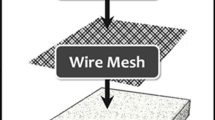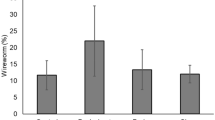Abstract
We describe the results of four laboratory studies designed to measure the effect of temperature and wireworm appetence, weight, and degree of Metarhizium infection on their ability to damage wheat seedlings. Wireworm activity, measured from wireworm speed, increased linearly from 6 to 18 °C and leveled off thereafter. Plant emergence and growth increased exponentially from 6 to 22 °C for wheat cultivars AC Barrie and AC Unity VB. Plant root:shoot ratio at Zadoks 13 was highest at 14 °C and lowest at 22 °C for AC Barrie. Wireworm weight and degree of infection with Metarhizium did not affect their ability to kill wheat seedlings, but wireworms in a feeding state caused significantly more damage than those in a non-feeding state when wheat was grown at 10, 14, 18, and 22 °C. Wireworms (ww) in a feeding state destroyed 1.8 seedlings/ww in 14 days at 22 °C if there were 1 or 2 wireworms in a pot, and 1.5 seedlings/ww if there were 4 wireworms in a pot. If 5 wireworms were placed in a pot, wireworms in a feeding state destroyed 0.3, 1.0, 0.9, 1.3, and 1.4 seedlings/ww in 46, 32, 25, 25, and 25 days at 6, 10, 14, 18, and 22 °C, respectively. Wireworm mortality from Metarhizium during 60 days of containment in pots in the study was higher in non-feeding than in feeding wireworms, and higher if wireworms were selected from a Metarhizium-infected colony than those selected from a non-infected colony. Some of the implications of these results for wireworm management and laboratory trials are discussed.
Similar content being viewed by others
References
Bierkander C (1779) Transactions of the Academy of Sciences in Sweden, p 285. (Cited in: Curtis, J (1860) Farm Insects. Blackie and Son, London, UK)
Burrage RH (1963) Seasonal feeding of larvae of Ctenicera destructor and Hypolithus bicolor (Coleoptera: Elateridae) on potatoes placed in the field at weekly intervals. Ann Entomol Soc Am 56:306–313
Comstock JH, Slingerland MV (1891) Wireworms. Bulletin 33 of the Agricultural Experiment Station. Cornell University, Ithaca
Crombie AC, Darrah JH (1947) The chemoreceptors of the wireworm (Agriotes spp.) and the relation of activity to chemical constitution. J Exp Biol 24:95–109
Davis GRF (1957) Growth and feeding behavior of larvae of Ctenicera aeripennis detructror (Brown) (Coleoptera: Elateridae) I. Effects of carrot slices and seeds of wheat, flax, barley, rye, and alfalfa. Ann Entomol Soc Am 50:578–584
Davis GRF (1971) Phagostimulatory effects of lipids and related substances on the prairie grain wireworm, Ctenicera destructor Brown. Can J Zool 49:1–4
Doane JF (1981) Evaluation of a larval trap and baits for monitoring the seasonal activity of wireworms in Saskatchewan. Environ Entomol 10:335–342
Doane JF, Lee YW, Klinger J, Westcott ND (1975) The orientation response of Ctenicera destructor and other wireworms (Coleoptera: Elateridae) to germinating grain and to carbon dioxide. Can Entomol 107:1233–1252
Equiza M, Miravé JP, Tognetti JA (2001) Morphological, anatomical, and physiological responses related to differential shoot vs root growth inhibition at low temperature in spring and winter wheat. Ann Bot 87:67–76
Evans AC (1944) Observations on the biology and physiology of wireworms of the genus Agriotes Esch. Ann Appl Biol 31:235–250
Evans AC, Gough HC (1942) Observations on some factors influencing growth in wireworms of the genus Agriotes Esch. Ann Appl Biol 29:168–175
Falconer DS (1945a) On the behaviour of wireworms of the genus Agriotes Esch. (Coleoptera: Elateridae) in relation to temperature. J Exp Biol 21:17–32
Falconer DS (1945b) On the movement of wireworms of the genus Agriotes Esch. (Coleoptera: Elateridae) on the surface of the soil and their sensitivity to light. J Exp Biol 21:33–38
Furlan L (1998) The biology of Agriotes ustulatus Schäller (Col., Elateridae) II. Larval development, pupation, whole cycle description and practical implications. J Appl Entomol 122:71–78
Huang BR, Taylor HM, McMichael BL (1991) Growth and development of seminal and crown roots of wheat seedlings as affected by temperature. Environ Exp Bot 31:471–477
Kabaluk JT, Ericsson JD (2007) Environmental and behavioral constraints on the infection of wireworms by Metarhizium anisopliae. Environ Entomol 36:1415–1420
King KM, Arnason P, Glen R (1933) The wireworm problem in field crops of western Canada. Leaflet 35 of the Canadian Department of Agriculture, Entomology Branch, Saskatoon, SK
Lees AD (1943a) On the behaviour of wireworm of the genus Agriotes Esch. (Coleoptera: Elateridae) I. Reactions to humidity. J Exp Biol 20:43–53
Lees AD (1943b) On the behaviour of wireworm of the genus Agriotes Esch. (Coleoptera: Elateridae) II. Reactions to moisture. J Exp Biol 20:54–60
Porter JR, Gawith M (1999) Temperatures and the growth and development of wheat: a review. Eur J Agronomy 10:23–36
van Herk WG, Vernon RS (2007a) Soil bioassay for observing the orientation, feeding, repellency, and post-contact toxicity behaviours of wireworms (Coleoptera: Elateridae) exposed to insecticide treated wheat seed. Environ Entomol 36:1441–1449
van Herk WG, Vernon RS (2007b) Morbidity and recovery of the Pacific Coast wireworm, Limonius canus, following contact with tefluthrin-treated wheat seeds. Entomol Exp Appl 125:111–117
van Herk WG, Vernon RS (2011) Mortality of Metarhizium anisopliae infected wireworms (Coleoptera: Elateridae) and feeding on wheat seedlings is affected by wireworm weight. J Entomol Soc BC 108:38–40
van Herk WG, Vernon RS (2013) Categorization and numerical assessment of wireworm mobility over time following exposure to bifenthrin. J Pest Sci. doi:10.1007/s10340-011-0381-2
van Herk WG, Vernon RS, Roitberg BD (2008a) Repellency of a wireworm, Agriotes obscurus (Coleoptera: Elateridae) on exposure to synthetic insecticides in a soil-less bioassay. Environ Entomol 37:534–545
van Herk WG, Vernon RS, Moffat C, Harding C (2008b) Response of the Pacific Coast wireworm, Limonius canus, and the dusky wireworm, Agriotes obscurus (Coleoptera: Elateridae), to insecticide-treated wheat seeds in a soil bioassay. Phytoprotection 89:7–19
van Herk WG, Vernon RS, Harding C, Roitberg BD, Gries G (2010) Possible aversion learning in the Pacific Coast wireworm. Phys Entomol 35:19–28
Vernon RS, van Herk WG (2012) Wireworms as pests of potato. In: Giordanengo P, Vincent C, Alyokhin A (eds) Insect pests of potato: Global perspectives on biology and management. Academic Press, Elsevier, Amsterdam, pp 103–164
Vernon RS, van Herk WG, Clodius M, Harding C (2009) Wireworm management I. Stand protection versus wireworm mortality with wheat seed treatments. J Econ Entomol 102:2126–2136
Zadoks JC, Chang TT, Konzak CF (1974) A decimal code for the growth stages of cereals. Weed Res 14:415–421
Acknowledgments
We are grateful to six excellent summer students—Amanda Stepto, James Elwood, Bryanna Lepine, Pierig le Pottier, Emmanuelle Bietz, and Shelby Snow—for their cheerful and reliable assistance, and to two anonymous reviewers for their constructive comments on the MS.
Author information
Authors and Affiliations
Corresponding author
Additional information
Communicated by M. Traugott.
Rights and permissions
About this article
Cite this article
van Herk, W.G., Vernon, R.S. Wireworm damage to wheat seedlings: effect of temperature and wireworm state. J Pest Sci 86, 63–75 (2013). https://doi.org/10.1007/s10340-012-0461-y
Received:
Accepted:
Published:
Issue Date:
DOI: https://doi.org/10.1007/s10340-012-0461-y




